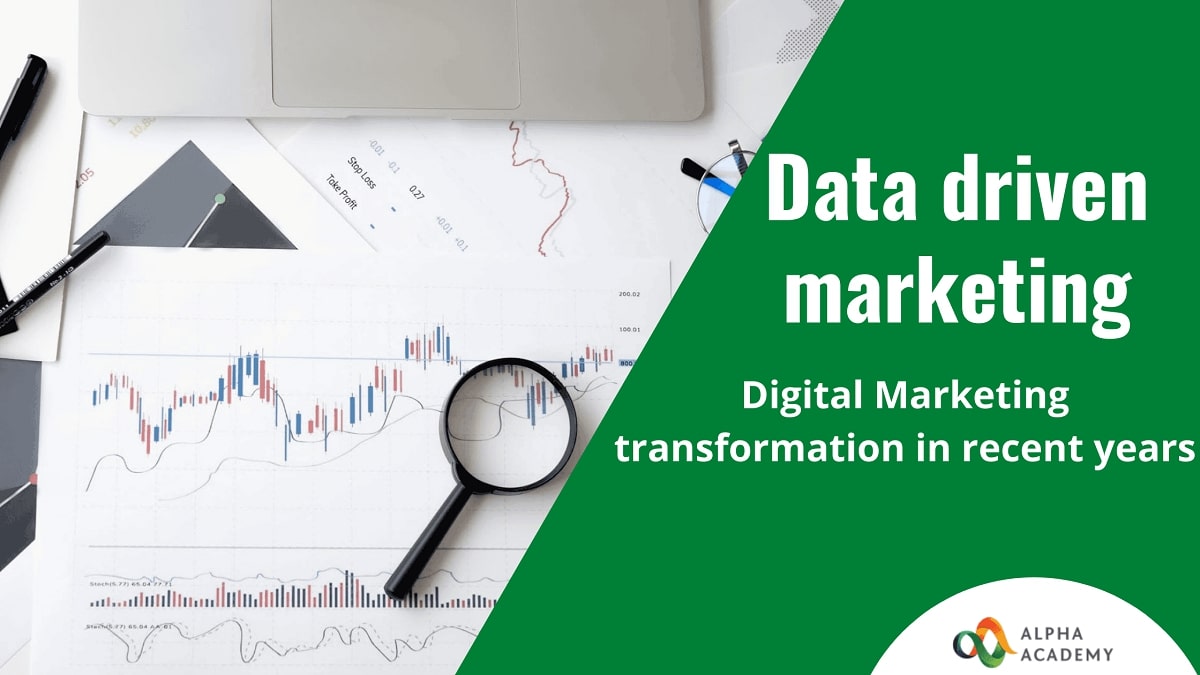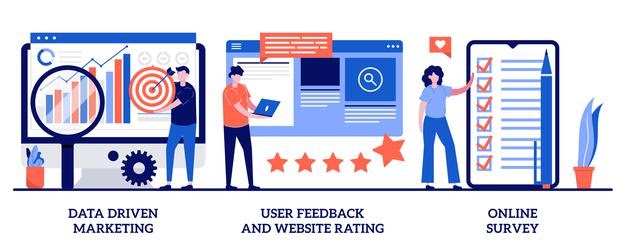
Who knew even near the end of the twentieth century that humans worldwide would get equipped with tiny black rectangular boxes that can do unimaginable things?
In this blog we will talk about Data-driven Marketing and Digital Transformation domains.
Data-Driven Marketing

Today, the world is being swept with waves of large data sets every second. Within 150 years, humans will have generated more data than there will be a total number of atoms in the entire world! Hence, understanding Data sets and putting them to good use can benefit business and marketing domains infinitely. Here is a brief discussion on what Data-driven Marketing is and the present and future of the Data-driven Marketing landscape.
What is Data-driven Marketing?
Classic offline Marketing has been here for quite some time. And all the way, there was a reason why Traditional Marketing was born. It served particular purposes of reaching a desired set of audience. But like everything, there were areas where Traditional Marketing happened to have inadequacies. And resultantly, the field of Marketing has experienced its own history of transformation.

What Makes Data-driven Marketing so Important Today?
Data-driven Marketing is an indispensable business need today. And the reason is short and simple. It’s building relationships with just the right audience in the right way. Filtered data is an elementary need for this.
How does Data-driven Marketing Work?
Data-driven Marketing primarily works in a four-step process.
Step 1- After the foundational work of setting goals and building teams and systems is completed, the cycle starts with Data collection. Data can be collected from primary sources or from third-party data providers. Usually, such data serve two goals- gathering customer information and identifying limitations in the business or finding further room for improvement. Then, these data are used to target the right audience segment, diversify market scopes and ultimately increase sales.
Step 2- Data collection is led by Data Activation. The collected data is used for creating personalized and effective marketing components for targeted audience segments. In this new era of Data, programmatic creative technologies are available for curating ad copies in ways that appeal to the right audience in a more personalized way.
Step 3- The activated data is used for launching Marketing campaigns. Marketing campaigns are carried out across targeted marketing channels for reaching out to prospects. Such campaigns are also conducted for interacting with existing customers and strengthening customer relationships. After the campaign ends, data on generated sales and revenue is gathered.
Step 4- After collecting, activating and using the data for marketing, the whole process goes through Analysis, monitoring and Evaluation. The findings are then implemented for refining Data-driven Marketing strategies, and the cycle repeats itself in loops.
What are Some Common Sources of Data Used in Digital Marketing?
It’s a well-known fact that the volume of data that’s been produced every second is overwhelming. So it’s only expected that the data used for intelligence and analytics flow in from many different sources. Some common sources are give below –
1. Surveys
2. Collecting Subscription and Registration Data
3. Online Tracking
4. Website Analytics
5. Social Media Metrics
6. Real-time DataTransaction History
7. SERP Analysis
How to Implement Data-Driven Marketing in a Business?
Like every other trade, Data-Driven Marketing is implemented in a step-by-step process.
The first and most obvious step is- Goal identification. Just getting started with the right goals is often not enough. Too often, setting the wrong goals can put the whole process on an unwanted trajectory.
For identifying the right goals, some organizational introspection is required. Then, after thoroughly examining the organisation’s current limitations and possibilities, such goals can be set. The use of data gets started here. Examples of such goals are setting a margin for scaling up revenues, targeting how many prospects to reach, etc.
Digital Transformation
Some say that society, in general, has experienced a lot more change in the digital era than it has in the past few centuries altogether. That’s the strength of digitalisation and what digitalisation is capable of doing.
What Makes Digital Transformation Indispensable Today?
On some levels, it is quite self-explanatory. Very little of the present world is beyond the scopes of Digitisation today. So businesses and enterprises have only so much of a choice when it comes to adopting digitisation.
Some Essential Scopes of Digital Transformation:
The scopes and aspects in which Digital Transformation can play key roles are as follows:
The Customer Journey in the Digital:
Tracking the buyer’s journey and gathering data from Customer satisfaction surveys generate information on how the existing customers experience their time with a company or organization. Using those insights, the places where customers reflect a lack of satisfaction can be spotted and improved.
System and Organizational Changes:
Digital Transformation requires unique expertise. For example, Data analysts, Data scientists, Content designers, Web and Application developers, etc. Cutting off all this expertise from the organizational structure can lead to a flimsy system.
While investing in all of these can take up a disproportionate chunk of the budget. Hence, well-planned change in the overall Organizational and system structure is another critical area of Digital Transformation.
Innovating What to Offer:
What potential customers are seeing on the internet these days truly influences their choices. So sticking to existing products and services without looking into how trends are shifting can result in overall backtracking.
Transforming the Scopes and Styles of Marketing:
Starting from Customer Acquisition to Customer Retention- the whole funnel goes through a different walk when digitised. How the advertisements and promotional messages are delivered, how communication is established with customers, how promotional campaigns are launched- everything takes a different set of skill and knowledge when a business moves to the digital.
Customer Relationship Management:
The days of door-to-door knocking for providing customer service are not necessarily long gone. But relying just on traditional offline customer service will undoubtedly fall short in today’s context.
Advanced chatbots, social media sales promoters, automated responses to frequently asked questions, and many other pieces of add-ons go into CRM pipelines these days.
Operational Aspects:
How the customer will communicate with the CRM front desk, how they will place their orders, how the products and services will be delivered to the customers, etc., fall within the scope of Digital Transformation in the operations.
Knowledge and Information Systems:
Availability of data, advanced analytics tools and increasing knowledge, resources and expertise every day allow businesses to have a lot more insights about themselves. Thus, the library of knowledge and information systems is getting enriched every now and then. Therefore, proper utilization of the generated data and analytics will require a transformation in the data storage, archival and processing pipelines.
What are the Challenges Associated with Digital Transformation?
The overwhelming abundance of data that keeps flowing can generate difficulties. And unless the right resources and team members are employed, all the valuable collected data can go to waste.
Financial investments can sometimes be beyond the feasible extent. Digital tools and employees with digital expertise aren’t exactly effortless on the budget all the time. But if the Return on Investment is well-planned and implemented, then the positive outcomes can be exponential.
Customer relationship management can sometimes be threatened by the shift in the product or service experience. Depending on loyalties and age groups, if the customer journey is not premeditated well, then there can be resistances from the customer pool.
The key here is to generate a customer-centric intent instead of adopting a product-centric approach.
Wrong audience segmentation can sometimes lead to communicating the messages the wrong way to the targeted audience. This happens when the digital shift in martech and ad-tech departments aren’t carried out with enough thoughts in the background.
Sometimes overdoing segmentation can lead to inefficiency and unwanted reactions. For example, over personalization can make the prospect or customer feel intruded. And too broad segments won’t help achieve the proper targeting. Thus, a lot of success boils down to well-conducted marketing segmentation.
Insufficient and incompetent expert insights can lead to ineffective yet expensive interventions sometimes. For example, without enough research- an investor can be advised on developing a mobile phone application. But Digital Transformation doesn’t necessarily always mean creating a mobile app or a website. Hence, if a mobile application is not likely to generate enough return on investment (ROI), then the whole process can generate poor outcomes in general.
If you want the basics, you just need to read Digital Marketing Basics for Beginners: The Ultimate Guide to start as a beginner.
Related Blogs:
1. World of Digital Marketing
2. The Future of Freelance Digital Marketing
3. Is Digital Marketing A Good Career?
4. Digital Marketing Strategy: 7 Effective Ways You should Consider
5. Digital Marketing Basics for Beginners: Ultimate Guide for skeptic mind
6. Top Reasons Why People Should Consider a Career in Digital Marketing
7. Five ways a Digital Marketing Course Can Improve Your Business
8. Digital Marketing Apprenticeships: A Guide for Beginners
Conclusion
Though conceptually intimidating, Data-driven Marketing and Digital Transformation can rotate the destinies of entrepreneurs by a complete three hundred and sixty degrees. Humanity has always excelled by innovation and because of innovation. And the abundance of data in the twenty-first century is only another leaf in the book, though that’s a big one indeed!
Data driven marketing: Digital Marketing transformation in recent years
Course Categories
- Accounting
- Animal Care
- Business
- Customer Service
- Design
- Digital Marketing
- Employability
- Food Hygiene
- General Education
- Health & Safety
- HR & Leadership
- IT & Software
- Languages
- Legal
- Makeup & Beauty
- Management
- Massage & Physiotherapy
- Mental Health & Counselling
- Microsoft Office
- Nursing & Care
- Personal Development
- Photography
- Prince2
- Project Management
- QLS Endorsed Course
- Sports, Nutrition & Fitness
- Teaching & Education
- Teaching & Special Education
- Training
- Travel and Tourism
- Web Design & Development











0 responses on "Data driven marketing: Digital Marketing transformation in recent years"